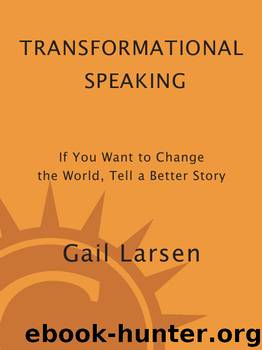Transformational Speaking by Gail Larsen

Author:Gail Larsen [Larsen, Gail]
Language: eng
Format: epub
ISBN: 978-0-8041-5189-4
Publisher: Potter/Ten Speed/Harmony/Rodale
Published: 2013-10-08T16:00:00+00:00
Different Thinking Styles
When something needs to get done in a fast-paced environment, the go-getters typically name a problem and decide on a course of action to solve it. This approach does not always lead to the best or most inventive decisions because people who need to explore emotions, meaning, and purpose before they get on board are left out of the decision-making process.
The Institute of Cultural Affairs, as part of its excellent training in group facilitation in which I participated, teaches a discussion method called ORID, a structure for effective communication that broadens perspectives and offers the potential for meaningful dialogue. ORID stands for objective, reflective, interpretive, and decisional or, as those of us studying it called it, what?, gut, so what?, and now what? Although it was designed for those leading conversations, ORID represents a winning formula for speakers who want to stimulate inquiry in the minds of audience members.
At the objective, or what?, level are the facts. Attention is on the basics, such as what people see and hear. This is where you provide the intellectual foundation of your speech.
The reflective, or gut, level stimulates emotional responses. It allows space to feel anger, excitement, and fear because people are reminded of a past association. Telling stories invites the audience to enter the reflective level.
At the interpretive, or so what?, level are values, meaning, and purpose. It brings up for people the significance they attach to a subject, even the story out of which they live. Asking questions such as “What does this mean to you?” and “What might this mean to your business?” stimulates personal interpretation and inquiry.
The decisional, or now what?, level, so common to our goal-oriented culture, is where individuals decide their relationship and response to the topic. It suggests next steps and asks people to take action.
A transformational speaker knows that inclusivity is paramount to getting people on board. By consciously incorporating material that appeals to all thinking styles into your presentation, you will speak to the entire audience, not a chosen few.
Download
This site does not store any files on its server. We only index and link to content provided by other sites. Please contact the content providers to delete copyright contents if any and email us, we'll remove relevant links or contents immediately.
Cecilia; Or, Memoirs of an Heiress — Volume 1 by Fanny Burney(32435)
Cecilia; Or, Memoirs of an Heiress — Volume 2 by Fanny Burney(31871)
Cecilia; Or, Memoirs of an Heiress — Volume 3 by Fanny Burney(31856)
The Lost Art of Listening by Michael P. Nichols(7409)
Asking the Right Questions: A Guide to Critical Thinking by M. Neil Browne & Stuart M. Keeley(5644)
We Need to Talk by Celeste Headlee(5544)
On Writing A Memoir of the Craft by Stephen King(4863)
Dialogue by Robert McKee(4323)
Pre-Suasion: A Revolutionary Way to Influence and Persuade by Robert Cialdini(4150)
I Have Something to Say: Mastering the Art of Public Speaking in an Age of Disconnection by John Bowe(3842)
Elements of Style 2017 by Richard De A'Morelli(3307)
The Book of Human Emotions by Tiffany Watt Smith(3238)
Fluent Forever: How to Learn Any Language Fast and Never Forget It by Gabriel Wyner(3031)
Name Book, The: Over 10,000 Names--Their Meanings, Origins, and Spiritual Significance by Astoria Dorothy(2940)
Good Humor, Bad Taste: A Sociology of the Joke by Kuipers Giselinde(2904)
Why I Write by George Orwell(2875)
The Art Of Deception by Kevin Mitnick(2736)
The Grammaring Guide to English Grammar with Exercises by Péter Simon(2711)
Ancient Worlds by Michael Scott(2626)
